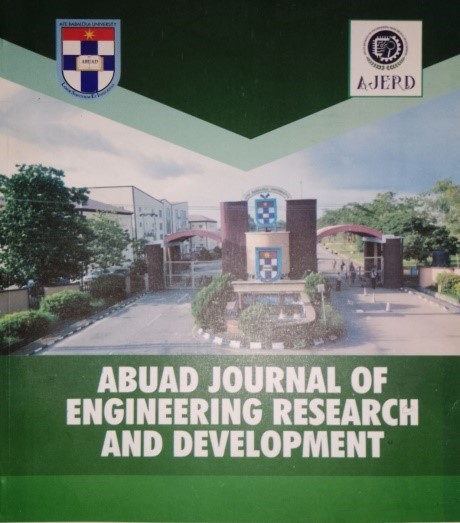Characterization and Beneficiation of Fanibi Laterite for Nickel Metal Recovery Using Froth Flotation Method
Main Article Content
Abstract
This study investigates the characterization of Fanibi Laterite and the efficiency of froth flotation to beneficiate nickel from its host rock sourced in Akure, Ondo State, Nigeria. A sample of the laterite was obtained and characterized by the use of an X-ray fluorescence Spectrometer (XRFS), X-ray diffractometer (XRD), and Scanning electron microscope with Energy dispersive spectroscope (SEM/EDS). The ore was comminuted to its liberation size of -125 + 90 µm. The froth flotation process was done using Sodium hydroxide and Hydrogen tetraoxosulphate (VI) acid as hydrogen potential (pH) modifier within the range of 4,5,7,9 and 10. However, other reagents are sodium oleate as the collector, potassium dichromate as the depressant, and oleic acid as the frother. The froth and depressed obtained were dewatered and characterized using XRFS. The result revealed that the ore contained 35.65% Si, 8.24% Al, 10.87% Fe, and 0.07% Nickel. It also included some other associated minerals such as Zn, Mg, Ti, Co, and Mo in trace form of less than 1 %. XRD analysis reveals nickel as nickel iodate. The result reveals nickel assays of 0.14, 0.20, 0.15, 0.25, and 0.12%, while their recoveries are 70.82, 67.80, 86.70, 98.04, and 86.98%, respectively. The optimum nickel recovery of 98.04% was attained at a pH of nine (9). It was concluded that froth flotation could successfully beneficiate Fanibi laterite ore for nickel. At the same time, other minerals such as Titanium, Molybdenum, Tin, and Tungsten were present to be extracted for Metallurgical applications.
Downloads
Article Details
References
Alabi, O.O., Yaro, S.A., Dungka, G.T., Asuke, F. & Dauda, E.T. (2015). Determination of Work Index of Gyel-Bukuru Columbite Ore in Plateau State, Nigeria. Journal of Minerals and Materials Characterization and Engineering, 3(1), 194 - 203. DOI: https://doi.org/10.4236/jmmce.2015.33022
Alabi, O.O. (2016). Beneficiation of Ajabanoko Iron Ore Deposit, Kogi State, Nigeria, Using Magnetic Methods. International Journal in Civil, Metallurgical and Energy Science, 2(3), 91-93.
Bacon, G. & Mihaylov, L. (2002). Solvent extraction as an enabling technology in the nickel industry. International Solvent Extraction Conference, Cape Town, South Africa, 102 (2), 435- 443.
Bamalli, U.S., Moumouni A., & Chaanda M.S., (2011). A Review of Nigerian Metallic Minerals for Technological Development. Scientific Research: Natural Resources, 2(1), 87-91. DOI: https://doi.org/10.4236/nr.2011.22011
Elliott, H. A. L., Gernon, T.M., Roberts, S., & Hewson, C., (2015). Basaltic Maar-diatreme Volcanism in the Lower Carboniferous in the Limerick Basin (SW Ireland). Bulletin of Volcanology, 77(1), 37-59. DOI: https://doi.org/10.1007/s00445-015-0922-2
Finkelstein, N.P., & Lovell, V.M. (1972). Fundamental Studies of the Flotation Process. Journal of South African Institute of Mining and Metallurgy, South Africa, 72(1), 328-342.
Foose, M.P., (1991). Nickel-Mineralogy and Chemical Composition of Some Nickel-Bearing Laterites in Southern Oregon and Northern California, 1, 1-24.
Gupta, C.K., (2003). Chemical Metallurgy: Principles and Practice. Verlag GmbH & Co. Weinheim, Berlin, Germany 36(3), 811. DOI: https://doi.org/10.1002/3527602003
Harris, C.T., Peacey, J.G., Pickles, C.A., (2013). Selective Sulphidation and Flotation of Nickel from a Nickeliferous Laterite Ore. Minerals Engineering, 54(1), 21-31. DOI: https://doi.org/10.1016/j.mineng.2013.02.016
Kawatra, S. (2011). Fundamental principles of froth flotation. SME mining engineering handbook.1, 1517-1532.
Olaniyan, O.S., Adisa, O.A., Ayinde, R.B. & Olagbemiro B.O. (2019). “Geotechnical Properties of Lateritic Soil at Some Selected Portions across Old Ogbomoso-Ilorin Road”, Journal of Sustainable Construction Engineering and Project Management, 2(3), 1–7.
Oloruntoba, D.T., Alabi, O.O. & Ajisafe, B. (2017). Characterization of Fanibi Laterite Deposit towards Recovery of Valuable Minerals for Extraction Purposes, FUTA Journal of Engineering and Engineering Technology, 1(1), 31-37.
Oyeladun, O.A.W., Thomas, D.G. & Yaro, S.A. (2012). Determination of the Chemical Composition and the Work Index of Rafin Gabas Chalcopyrite Ore. Nigerian Mining Journal, 10(1), 37-47.
Petrakis, E., Karmali, V. & Komnitsas, K. (2021). Factors affecting nickel upgrade during selective grinding of low-grade limonitic laterites. Mineral Processing and Extractive Metallurgy, 130(3), 192-201. DOI: https://doi.org/10.1080/25726641.2018.1521578
Quast, K., Otsuki, A., Danie, I.J., Robinson, & Addai-Mensah J. (2015). Preconcentratios strategies in the processing of nickel laterite ores part 3: Flotation testing. Elsevier-Mineral Engineering, 79(1), 279-286 DOI: https://doi.org/10.1016/j.mineng.2015.03.018
Rhamdhani, M.A., Chen, J., Hidayat, T., Jak, E., & Hayes, P., (2009). Advances in research or nickel production through the Caron Process. Researchgate - Proc. of 5th European Metallurgical Conference, 4(1), 1-17.
World of Earth Science (WES) (2003). Laterite. The Gale Inc., Detriot, Michigan, USA, 1, 1-600.
World Bank Group (WBG) (1998). Nickel Smelting and Refining. Pollution Prevention and Abatement Handbook, 349-352.




